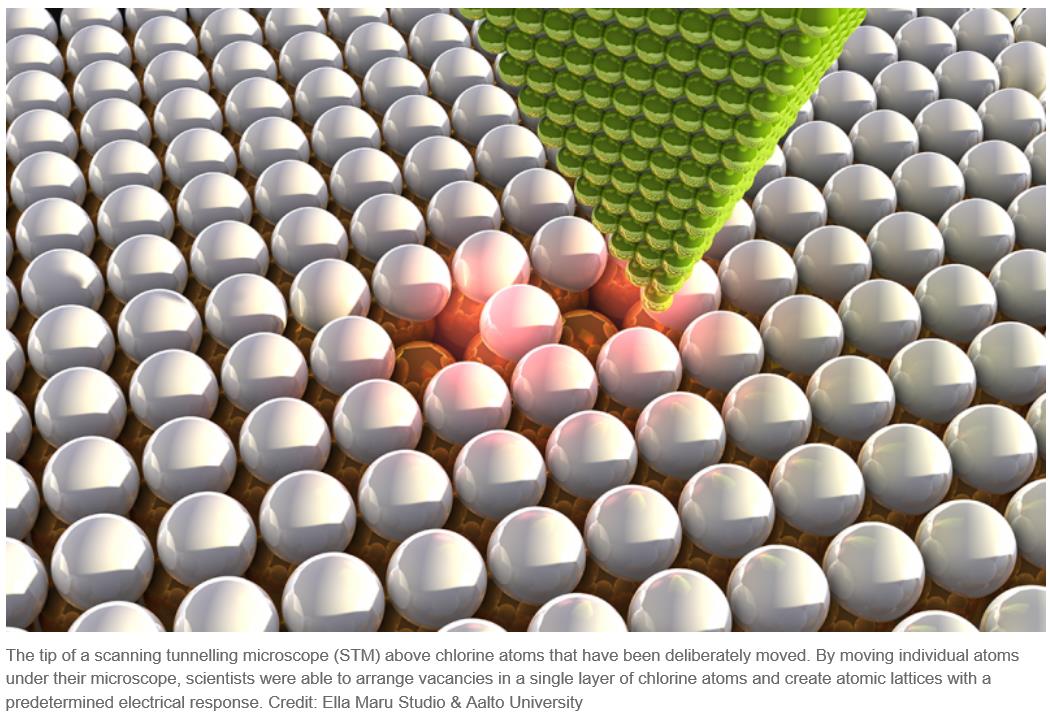博文
Nat. Phys.:操控单原子创造新材料
|||
诸平

据芬兰阿尔托大学(Aalto University)2017年3月27日提供的消息,阿尔托大学理学院应用物理系的研究人员通过操作单个原子可以创建特殊新材料,即原子晶格和预设的电响应,此研究成果于2017年3月27日在《自然物理》(Nature Physics)杂志网站发表——Robert Drost, Teemu Ojanen, Ari Harju, Peter Liljeroth. Topological states in engineered atomic lattices. Nature Physics, 2017, DOI:10.1038/NPHYS4080.
Publishedonline: 27 March 2017.其实,此项研究成果早在2016年11月3日就已经在预印本文库网站(arXiv:1611.01049 [cond-mat.mes-hall])公布于众,而且在2016年11月11日又向预印本文库网站提交了修改稿(arXiv:1611.01049v2 [cond-mat.mes-hall] forthis version)。上图是由阿尔托大学提供的故意转移上层氯原子的扫描隧道显微镜(STM)照片。通过在显微镜下移动单个原子,科学家们能够在氯原子单层安排空缺,以创建具有预定电响应的原子晶格。
阿尔托大学的研究人员已经制造出具有工程电子性质的人工材料。他们在显微镜下通过移动单个原子,能够创建具有预定电响应的原子晶格。这意味着在一个样品中精确地安排原子是完全可能的,这距离“设计师的量子材料(designer quantum materials)”的现实更接近了一步。通过在晶格中安排原子,工程师就有可能通过原子结构的人为设计而达到改变材料电子性质之目的。如在工作温度为4 K条件下,研究人员利用扫描隧道显微镜(STM)在Cu(100)平面上的氯原子层就可以安排空缺。
在芬兰阿尔托大学进行实验的罗伯特·德罗斯特博士(Dr. Robert Drost)说:“原子结构和电子性质之间的对应关系当然在真实材料中是客观存在的,但是在我们的实验中已经完全可以对其结构进行控制。原则上,我们可以以任何电子属性作为目标,在实验上加以实施。”
使用阿尔托大学研究人员的原子组装方法,研究小组受到具有独特电子性质的基本模式系统的启发,已经证明完全可以人为控制原子创建了2个真实结构。而且这种方法并不局限于阿尔托大学研究团队选择的氯系统。同样的方法可以应用在许多容易理解系统的表面和纳米科学领域,甚至可以适应于介观系统(mesoscopic systems),如量子点,通过光刻过程对其加以控制。阿尔托大学的学术研究人员,也是上述《自然物理》发表的研究结果的第二作者泰穆·奥贾奈(Teemu Ojanen)解释道:“有很多迷人的理论建议是真正材料中就根本不存在的,但这正是我们在实验上来检验这些理论预测结果的一个良机。”
更多信息请浏览原文(摘要如下)或者 Spot-weldinggraphene nanoribbons atom by atom
Abstract
Topological materials exhibit protected edge modes that have been proposed for applications in, for example, spintronics and quantum computation. Although a number of such systems exist1, 2,3, 4, 5, 6, it would be desirable to be able to test theoretical proposals in an artificial system that allows precise control over the key parameters of the model7. The essential physics of several topological systems can be captured by tight-binding models, which can also be implemented in artificial lattices6, 7. Here, we show that this method can be realized in a vacancy lattice in a chlorine monolayer on a Cu(100) surface. We use low-temperature scanning tunnelling microscopy (STM) to fabricate such lattices with atomic precision and probe the resulting local density of states (LDOS) with scanning tunnelling spectroscopy (STS). We create analogues of two tight-binding models of fundamental importance: the polyacetylene (dimer) chain with topological domain-wall states, and the Lieb lattice with a flat electron band. These results provide an important step forward in the ongoing effort to realize designer quantum materials with tailored properties.
https://wap.sciencenet.cn/blog-212210-1042187.html
上一篇:昨天的4篇“精选”
下一篇:光子研究新发现挑战量子论